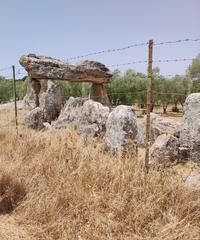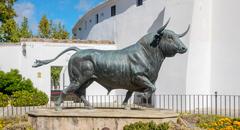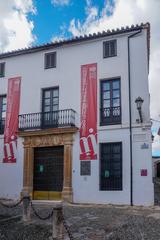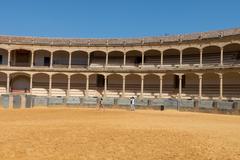Centro Histórico de Ronda: Visiting Hours, Tickets, and Essential Visitor Guide
Date: 14/06/2025
Introduction
Perched atop the dramatic cliffs of El Tajo gorge in Andalusia, the Centro Histórico de Ronda stands as one of Spain’s most evocative and historically layered urban centers. From ancient origins through Roman, Islamic, and Christian eras, Ronda’s historic heart is a living showcase of cultural evolution and architectural achievement. Here, visitors encounter renowned landmarks such as the Puente Nuevo, an 18th-century engineering marvel bridging the old Moorish quarter and the newer city, and the Plaza de Toros de Ronda, one of the most storied bullrings in Spain (info.turismoderonda.es; adventurebackpack.com).
Designated a “Conjunto Histórico-Artístico” in 1966, Ronda’s historic center preserves a vibrant mosaic of influences—Roman ruins, Islamic architecture, Gothic churches, and Renaissance palaces—all narrating Ronda’s strategic role and cultural transformations. Visitors are drawn into the winding streets of the Moorish quarter, formidable city walls, and sites like the Baños Árabes and Palacio de Mondragón, each offering a distinct window into Ronda’s past (revistaseug.ugr.es; turismoderonda.es).
To maximize your visit, it’s vital to know the practicalities—opening hours, ticket prices, accessibility, and seasonal tips. While many landmarks are open daily (typically 9:30 AM–7:00 PM), and outdoor sites like Puente Nuevo are free, museums and special sites charge modest entry fees. Accessibility has improved, but the cobblestone terrain and steep inclines require preparation for those with mobility needs (rondatoday.com; spanishplains.com).
Beyond sightseeing, Ronda’s historic center pulses with culture—annual events like the Feria de Pedro Romero, guided tours, and panoramic viewpoints define the visitor experience. For those seeking authentic history, vibrant traditions, and breathtaking scenery, the Centro Histórico de Ronda is an unmissable destination (adventurebackpack.com; turismoderonda.es).
Contents
- Historical Overview
- Key Historical Landmarks
- Visiting Hours, Tickets, and Accessibility
- Special Events and Guided Tours
- Photographic Spots
- Visitor Tips
- How to Get There & Orientation
- Accommodation & Dining
- FAQs
Historical Overview
Ancient and Medieval Roots
Evidence of human settlement in Ronda dates back to the Paleolithic era, with the nearby Cueva de la Pileta exhibiting ancient cave art over 25,000 years old (info.turismoderonda.es; rondaexperience.com). Celtic tribes established “Arunda” by the 6th century BCE, and nearby Acinipo (a Phoenician, later Roman, town) highlights Ronda’s early multicultural significance.
Under Roman rule, Ronda became a municipium, with amphitheater remains at Acinipo attesting to its importance (info.turismoderonda.es). The Visigothic period maintained Ronda’s strategic role until the Islamic conquest of the early 8th century.
Ronda flourished under Islamic rule, known as “Izna Rand Onda” or “Onda,” serving as a regional capital. The city’s urban fabric took shape with fortified walls, gates, and the Baños Árabes (Arab Baths)—some of Spain’s best-preserved examples (adventurebackpack.com). The Nasrid and Taifa periods cemented Ronda’s reputation as a key frontier city.
The Christian conquest in 1485 brought sweeping changes: mosques were converted to churches, new squares were created, and the Iglesia de Santa María la Mayor rose atop the old mosque, blending Gothic and Mudejar styles (adventurebackpack.com).
Modern Expansion and Cultural Legacy
The 18th century sparked major urban development. The Puente Nuevo (completed 1793) dramatically united the city’s old and new quarters over the El Tajo gorge (visitanddo.com). The Plaza de Toros de Ronda, inaugurated in 1785, became a cradle for modern bullfighting (allaboutevesjourneys.com).
The Romantic era brought international attention, with writers like Hemingway and Welles drawn to Ronda’s bandoleros, dramatic scenery, and vibrant traditions (tallgirlbigworld.com).
Key Historical Landmarks
- Puente Nuevo: 18th-century bridge spanning the 120-meter El Tajo gorge, linking old and new Ronda. Includes a small museum (adventurebackpack.com).
- Plaza de Toros de Ronda: Historic neoclassical bullring, central to Spanish bullfighting heritage, with an adjoining museum (allaboutevesjourneys.com).
- Iglesia de Santa María la Mayor: Church blending Gothic and Mudejar styles, built atop the city’s former mosque (adventurebackpack.com).
- Palacio de Mondragón: Former Moorish palace, now Ronda’s Municipal Museum (visitanddo.com).
- Casa del Rey Moro: 18th-century mansion atop a Moorish water mine, with unique gardens (adventurebackpack.com).
- Baños Árabes: Exceptionally preserved 13th–14th-century Islamic baths (adventurebackpack.com).
- Moorish Quarter & City Walls: Labyrinthine streets, whitewashed houses, and remnants of medieval fortifications (adventurebackpack.com).
- Puente Viejo & Puente Romano: Historic bridges reflecting Ronda’s continuity across eras.
Visiting Hours, Tickets, and Accessibility
| Site | Typical Hours | Admission | Accessibility |
|---|---|---|---|
| Puente Nuevo | 24/7 (views); Museum 10–18h | Bridge: Free; Museum ~€2.50 | Museum has steps; viewpoints partially accessible |
| Plaza de Toros | 10:00–18:00 | ~€8 adults; discounts | Partial wheelchair access; call ahead for details |
| Baños Árabes | 09:30–17:30 (Mon–Sat) | ~€3 | Uneven floors; limited accessibility |
| Palacio de Mondragón | 09:30–17:30 (Tue–Sun) | ~€4 | Partial accessibility |
| Casa del Rey Moro | 09:30–18:00 | ~€6 | Steep steps; gardens more accessible |
| Iglesia de Santa María | 10:00–18:00 (Mon–Sat); 10:00–14:00 (Sun) | Free/donation | Most areas accessible; tower not recommended |
Note: Opening hours may vary by season. Confirm via official websites before visiting.
Tourist Ticket (Bono Turístico): Bundled entry to several attractions for ~€15 (rondatoday.com).
Special Events and Guided Tours
- Feria de Pedro Romero (early September): Ronda’s main festival, featuring parades, the Corrida Goyesca bullfight, and flamenco.
- Semana Santa: Religious processions and cultural festivities.
- Ronda Romántica (May): Historical reenactments and 19th-century traditions.
Guided Tours: Available in multiple languages, covering major sites and hidden gems. Book at the Tourist Office or online (turismoderonda.es).
Photographic Spots
- Puente Nuevo Viewpoints: Best light early morning or late afternoon.
- Jardines de Cuenca: Terraced gardens overlooking the gorge.
- Mirador de Aldehuela: Panoramic city and gorge views.
- Plaza de Toros: Iconic arena and surrounding architecture.
Visitor Tips
- Best Time to Visit: Spring and autumn for mild weather and fewer crowds. Early mornings and late afternoons are quieter (wanderlustphotosblog.com).
- Footwear: Wear sturdy, comfortable shoes for cobblestones and hills.
- Accessibility: Historic terrain can be challenging; plan accordingly.
- Dining: Try local tapas and regional specialties in atmospheric squares (adventurebackpack.com).
- Language: Spanish is official; English widely spoken in tourist zones.
How to Get There & Orientation
- By Train: Direct services from Málaga, Seville, and other cities. The station is a 15-minute walk from the historic center.
- By Car: Well-connected roads; use public parking lots as historic center parking is limited (earthtrekkers.com).
- By Bus: Regular buses from Málaga, Seville, and nearby villages.
Navigating Ronda: The historic center is compact and pedestrian-friendly. Main thoroughfares include Calle Armiñán, Calle Espinel (La Bola), and Calle Virgen de la Paz. Tourist maps and information are available at the Tourist Office near Plaza de Toros (rondatoday.com).
Accommodation & Dining
- Stay: Parador de Ronda (next to Puente Nuevo), boutique hotels, guesthouses, and apartments abound in the historic core (rondaparador.com).
- Eat & Drink: Tapas bars and restaurants are clustered around Plaza Duquesa de Parcent, Plaza del Socorro, and Calle Espinel (rondatoday.com). Reservations recommended for dinner.
Frequently Asked Questions (FAQs)
Q: What are the main visiting hours for Ronda’s historic sites?
A: Most open 9:30 or 10:00 AM–5:30 or 6:00 PM; some close on Mondays.
Q: Where can I purchase tickets?
A: At each site, the Tourist Office, or online. The Tourist Ticket offers bundled entry.
Q: Is the historic center accessible for wheelchairs?
A: Many areas are accessible, though cobblestones and steep streets pose challenges.
Q: Are guided tours available in English?
A: Yes, book at the Tourist Office or online.
Q: What’s the best time to visit to avoid crowds?
A: Early mornings, late afternoons, spring, and autumn.
Further Resources
- Official Ronda Tourism Website
- Centro Andaluz de Ronda
- Ronda Today: The Tourist Ticket
- Adventure Backpack: Ronda Landmarks
- Spanish Plains: Ronda Travel Guide
- Turismo de Ronda Official
Summary
The Centro Histórico de Ronda is a stunning crossroads of history, culture, and natural beauty. Its iconic bridges, ancient baths, and vibrant plazas create a tapestry that rewards both deep exploration and casual strolls. With well-preserved sites, engaging festivals, and practical visitor amenities, Ronda offers an immersive Andalusian experience. Plan ahead for visiting hours and accessibility, embrace local traditions, and let each winding street reveal a new story from the city’s rich past.
For expert-guided tours and insider tips, download the Audiala app and follow official tourism channels for the latest updates. Make Ronda’s historic heart the highlight of your Andalusian adventure!
Sources
- Centro Histórico de Ronda: Visiting Hours, Tickets, and Historical Sites Guide (info.turismoderonda.es)
- Ronda Centro Histórico: A Complete Visitor’s Guide to History, Culture, and Practical Tips (revistaseug.ugr.es)
- Must-See Historical Sites in Ronda’s Centro Histórico: Visiting Hours, Tickets & Tips (spanishplains.com)
- Centro Histórico de Ronda Visiting Hours, Tickets & Travel Guide (turismoderonda.es)
- Ronda Today: The Tourist Ticket – The Best Way to Visit Ronda’s Top Attractions (rondatoday.com)
- Adventure Backpack: Ronda Landmarks and Culture (adventurebackpack.com)
- Turismo de Ronda Official Website (turismoderonda.es)
- Spanish Plains: Ronda Spain – A Whirlwind of History, Culture, and Breathtaking Views (spanishplains.com)



